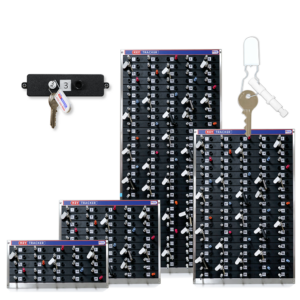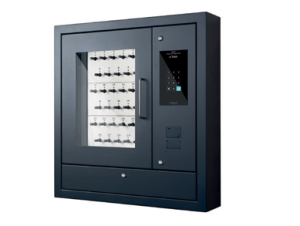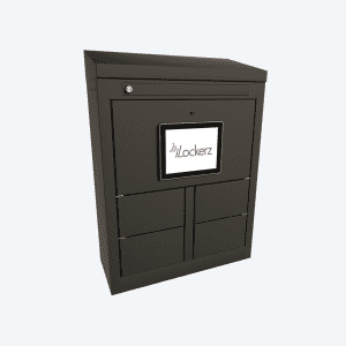The Ultimate Guide to Key Management Systems
The Ultimate Guide to Key Management Systems
In the modern business landscape, there are countless elements to manage, yet the question of “where your keys are” should certainly not be among your concerns. However, overseeing these vital items poses considerable challenges, from monitoring countless keys across various departments to thwarting unauthorised access and upholding stringent security protocols.
Having spent thirty years assisting organisations in tackling these challenges, we’ve seen for ourselves how effective key management can revolutionise security operations. When NHS Trust facilities achieved a remarkable 94% reduction in key loss, or when Govia Thameslink Railway successfully eliminated their daily 30-minute key searches, these were not merely enhancements in security; they signified profound operational transformations.
Table of contents
1. What is a key management system?
In straightforward terms, a key management system serves as an effective method for monitoring your keys, be it for properties, vehicles, or various other assets. Key Management Systems facilitate the check-in and check-out process for staff members requiring access to keys. Certain key management systems are designed to monitor your keys, ensuring that you remain in control of your assets, even if they happen to go missing.
2. Varieties of Key Management Systems
Key management systems have undergone remarkable evolution, transitioning from the original peg-in, peg-out boards to advanced electronic solutions. Every type presents unique benefits tailored to various organisational needs, security demands, and financial considerations.
 Mechanical Systems
Mechanical Systems
Mechanical key management systems embody the classic method of key control, providing straightforwardness and dependability without the need for power or network connections.
Essential Features:
- Peg-in, Peg-out Boards: Tangible boards designed for securing keys to pegs that firmly lock into specific positions.
- Key Cabinets: Secure cabinets featuring numbered hooks or slots for neatly organised key storage
- Manual Logging: Utilising paper records or basic spreadsheet methods to monitor key movements
- Seal Tags: These are tamper-proof tags designed to prevent unauthorised access to keys.
- Access Pegs: Locked in the system when a key is removed, to visualise who has which key instantly.
Who is the ideal candidate for a mechanical key management system?
- Minor organisations with a restricted number of key sets
- Settings where power or network connectivity is inconsistent
- Cost-effective solutions with fundamental security requirements
- Areas characterised by low staff turnover and minimal key personnel changes
 Electronic Systems
Electronic Systems
Electronic key management systems are the benchmark for secure and accountable key control in a wide array of professional settings. These systems seamlessly integrate physical security with digital tracking and access control.
Essential Features:
- User Authentication: Secure access through PIN codes, RFID cards, or biometric verification
- Automated Tracking: Comprehensive digital logging of all key movements, complete with time stamps
- User Permissions: Detailed control over which users can access particular keys
- Alerts & Notifications: Automated alerts for overdue keys or unauthorised access attempts.
- Reporting Capabilities: Comprehensive audit trails and usage analytics.
Ideal For:
- Medium to large enterprises with numerous key sets
- Settings necessitating comprehensive audit trails for compliance
- Operations involving multiple users with varying access permissions
- Security-sensitive applications where accountability is paramount
Case Study: Govia Thameslink Railway has adopted KeyTracker’s electronic key cabinet system to efficiently oversee access to train cab door keys, depot door keys, and equipment keys at various locations. The system has successfully cut key loss incidents by a remarkable 92% and has eradicated the 30+ minutes that were once wasted searching for misplaced keys. The comprehensive audit trails have also streamlined adherence to railway security regulations, offering documented proof of regulated key access.
 Smart Lockers
Smart Lockers
Smart lockers are the pinnacle of asset management solutions, offering more than just basic asset control; they efficiently oversee a range of assets within secure, traceable compartments.
Key Features:
- Modular Design: Tailor-made configurations featuring various compartment sizes
- Multi-Asset Storage: A secure solution for your equipment, devices, and documents.
- Enhanced Security: Options for multi-factor authentication
- Integration Capabilities: Seamless API connections to access control, HR, and security systems.
- Remote Management: Effortless cloud-based oversight of multiple locations from a central dashboard.
Ideal For:
- Enterprises requiring sophisticated asset management solutions
- Environments that demand secure storage for a range of assets beyond just keys
- Businesses seeking effortless integration with their current security systems
- Operations across multiple locations that require centralised management
LIKE WHAT YOU ARE READING?
CONTACT OUR EXPERT TEAM TODAY
Call us on +44 (0)121 559 9000 or email: sales@keytracker.com and one of our expert team will be in touch to discuss your requirements.
3. Advantages of implementing a key management system
Introducing a well-organised key management system brings tangible advantages across various operational sectors. Drawing from insights gathered from our clients spanning multiple industries, here are the primary benefits you can anticipate:
- Improved Security and Mitigated Risks
- Preventing Unauthorised Access: A remarkable 89% of organisations have reported the successful elimination of unauthorised key access following implementation.
- Reducing Key Loss: There has been an impressive average reduction of 94% in lost keys within the first year of deploying the system.
- Creating Accountability: Comprehensive audit trails provide clear responsibility for every key movement.
- Supporting Compliance: Automated documentation assists in meeting regulatory requirements effectively.
“Prior to the introduction of KeyTracker’s system, we were facing an average of 14 lost keys each month.” Since the installation 18 months ago, we haven’t lost a single key. – Facilities Manager at Horlicks Quarter
Enhancements in operational efficiency
The operational advantages go beyond security to include basic business performance measures:
When searching for keys (from 15+ minutes to under 3 minutes), our automotive customers say they save an average of 82%, which means they regain productive time worth about £8,400 per year per site.
- Property management clients say they spend 76% less time on key-related administrative tasks, which lets them assign staff to more important activities.
- Process Standardisation: With employee training time cut by an average of 65% for new hires, multi-site operations report notable advantages from standardised key handling practices.
- Usage statistics enable companies to right-size their key inventory and find inefficient resource allocation; one facilities management customer cut their key inventory by 34% while enhancing access capabilities.
Financial consequences
Key management’s financial justification is strong; usually, return on investment is reached in months:
- Depending on organisation size and key complexity, average annual savings on replacement keys and locks range from £3,200 to £7,500.
- A usual 50-key system recovers about 250+ staff hours per year from key search and manual log administration, worth over £3,750 at average pay rates.
- Organisations employing smart lockers for both keys and equipment claim average yearly savings of £12,400 from lower equipment loss and damage.
- Security and facilities teams say 64% less time spent looking into key-related security incidents, with average annual investigation cost savings of £5,200.
These advantages are not hypothetical; they are recorded outcomes from our real UK client deployments. To constantly improve our strategy and measure the actual value provided, our committed customer success team monitors implementation results.
Risk Management & Compliance
Key management systems offer vital compliance help for companies under legal obligations:
- Automated reports meet criteria for several standards, including ISO 27001, Secured by Design, and industry-specific rules.
- Of KeyTracker users, 47% say their insurance costs have gone down following implementation; many insurers clearly need official key management.
- With customers saying much better results in liability claims, whole audit trails offer vital evidence in incident investigations.
- Appropriate key management guarantees vital access may be preserved during staff changes or crises, therefore lowering operational vulnerabilities.
Case Study: Shield Security
A UK-based security services firm, Shield Security used KeyTracker’s electronic key management system throughout their operations and recorded these outcomes:
Elimination of lost client keys to 100% (previously averaging 7 incidents annually)
From 45 minutes to under 3 minutes, time spent searching for keys dropped 94%.
Annual savings of £11,200 from avoided lock replacements and administrative overheads
Improved customer confidence resulting in a 23% rise in contract renewals
OUR PRODUCTS FOR YOU
4. How to Choose the Right Key Management Solution
To understand your needs in your key management system, we’ve built a scenario-based understanding of typical activities across a business. We’ve compared key tracking to key management to highlight the differences and help you decide:
| Scenario | Key Tracking Approach | Key Management Approach |
|---|---|---|
| New employee needs access | Adds employee to users who can check out keys | Analyses access requirements, assigns specific permissions based on role and need |
| Key not returned on time | Records that key is still checked out | Sends automatic alerts, escalates to supervisors, potentially triggers security protocols |
| Department needs change | Manually adjusts who uses which keys | Systematically reviews access patterns, adjusts permissions across the organisation, updates policies |
| Security incident occurs | Provides record of who had the key | Delivers comprehensive audit trail, supports investigation, implements preventive measures for future |
| Contractor requires temporary access | Creates temporary log entry | Creates time-limited access with automatic expiration, restricts to specific hours/days |
How to approach each solution:
Key Tracking is Often Sufficient When:
- You have a small organisation with limited key sets
- Security requirements are basic
- Few people need access to keys
- Compliance requirements are minimal
- Budget constraints are significant
Key Management is Typically Necessary When:
- You manage keys across multiple departments or locations
- Regulatory compliance requires detailed access records
- Different users need different access privileges
- Security risks associated with keys are substantial
- Operational efficiency is significantly impacted by key-related issues
How does this work in the real world?
Here are some typical questions to answer before deciding which approach is best for you:
Size and Complexity
- How many keys have to be controlled?
- How many users require key access?
- How many sites require key management systems?
- How often are keys used (transactions per day)?
Requirements for Security
- Should keys be misused or lost, what security consequences follow?
- Is key control subject to particular compliance criteria?
- Do various keys call for various security levels?
- Should access be time-limited or temporary?
Operational Issues
- Who will run the key management system?
- Would you require integration with other systems (HR, access control)?
- Are there environmental elements to take into account (outdoor use, severe conditions)?
- How essential is remote management capacity?
Financial Considerations
- What is the starting investment budget?
- What are the allowed continuing expenses?
- How crucial is clear ROI?
- How long should the system be useful?
How not to go about it!
Our experience has helped us to find these common errors in the choosing procedure:
Choosing a system that satisfies present needs but lacks growth potential usually results in premature replacement.
- Ignoring Total Cost of Ownership: Ignoring continuous expenses, maintenance, and possible upgrade requirements, one concentrates only on the initial purchase price.
- Choosing security features depending on general impressions rather than particular risk assessment for your surroundings.
- Ignoring User Experience: Putting in place secure but inconvenient systems that cause workarounds and lower compliance.
- Inadequate Integration Planning: Failing to consider how the key management system will connect with other security and administrative systems.
5. Implementation Best Practice
A successful key management implementation requires more than just installing hardware and software, it demands thoughtful planning, effective change management, and ongoing optimisation. Based on our experience implementing thousands of systems across the UK, these best practices will help ensure your implementation delivers maximum value.
- Choose the right system for you
- Ensure all relevant staff are aware of the new system before installation
- Prepare an area for the Key Management System to be installed
6. Industry Applications
Our key management systems have been used across a wide range of industries, here are some examples:
7. Frequently Asked Questions
A key management system is a secure solution designed to control, track, and manage physical keys within an organisation. It typically consists of hardware components (such as electronic cabinets, mechanical boards, or intelligent lockers) and software that records key usage, restricts access to authorised users, and provides comprehensive audit trails. Modern key management systems help eliminate key loss, unauthorised access, and administrative inefficiency while providing full visibility of all key movements.
Unlike informal methods of hanging keys on hooks or storing them in desk drawers, proper key management systems provide accountability, traceability, and security through structured processes and technologies specifically designed for key control.
Key tracking systems use unique identifiers (such as RFID tags, electronic fobs, or mechanical pegs) attached to each key or key set. When keys are removed or returned, the system records who took the key, when it was taken, when it’s due back, and often the purpose of use.
In electronic systems, users authenticate themselves via PIN codes, access cards, or biometric verification before being granted access to specific keys. The system automatically records all transactions, creating a complete audit trail. Many systems include additional features like automatic notifications for overdue keys, time-restricted access, and usage pattern analysis.
This creates accountability, prevents unauthorised access, and provides a complete audit trail of all key movements. Advanced systems can integrate with other security infrastructure and provide sophisticated reporting and analytics capabilities.
Key tracking focuses specifically on monitoring the location and usage of keys, answering the basic questions “where is this key?” and “who has it?” It’s primarily concerned with recording key movements and maintaining basic accountability.
Key management is a broader concept that encompasses the entire process of controlling, securing, and administering keys, including:
- Defining access permissions and user roles
- Enforcing usage policies and procedures
- Managing the complete lifecycle from issuance to retirement
- Integrating key control with broader security frameworks
- Analysing usage patterns for security and efficiency
- Implementing proactive security measures
Think of key tracking as a crucial component within the larger key management framework. While simple tracking might be sufficient for small organisations with limited key sets, comprehensive management becomes essential as key inventories grow and security requirements increase.
TESTIMONIALS
“The main reason for implementing a KeyTracker system into the business was for a fast and efficient service. The best thing about the system is that it’s quick, efficient, and of high quality. It also generates a fast response time and provides great customer service and quality. The business journey with KeyTracker from discovery to installation to aftersales has been amazing. To any potential customers, go ahead. It will help enhance business for sure.” Seiawsh Kakar, Foxtons (Property)
“The biggest difference we have noticed is that nobody needs to manage the keys anymore, previously someone would have to hand the keys out or we wouldn’t know who had taken them, now we can glance at the KeyTracker system and instantly see who has it. It’s saved so much time already.” Gaye Poole, Office Manager, First Choice Cleaning & Maintenance Services. (Facilities Management)
“Some benefits of the KeyTracker’s system are having access to staff keys, in case of an emergency, Staff knowing that their keys are safe and can’t be lost during shift and a reduced cost of vehicles being put off-shift if keys are not present. KeyTracker are absolutely amazing, professional, personal and exactly as advertised!” Station Manager, All Wales Ambulance Service. (Station Manager)
“Our business journey with KeyTracker from discovery to installation and aftersales was flawless. The KeyTracker system has removed individuals’ choice, increased Team Leaders responsibility, removed H&S concerns of MHE misuse. It’s an effective key control measure”. Yusen Logistics.
“The system makes things a lot more organised, and process driven as we can control it. It is used by our 50+ staff and KeyTracker has improved our day-to-day operations as it is great quality, excellent service and has a great range of products. The best thing about KeyTracker are the lovely people we have arranging our orders.” Manager, Arden Maidstone BMW. (Franchise)